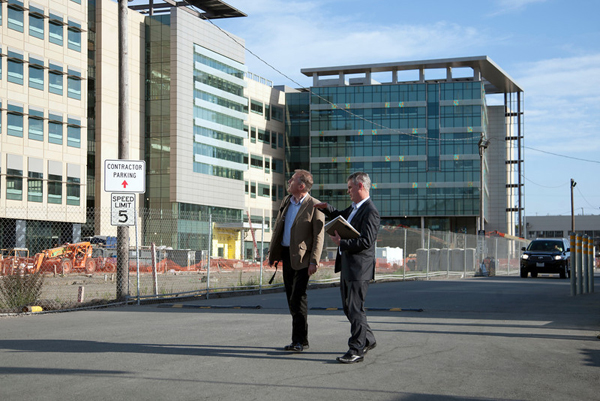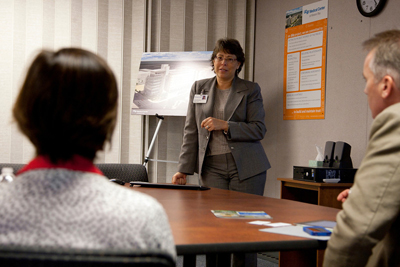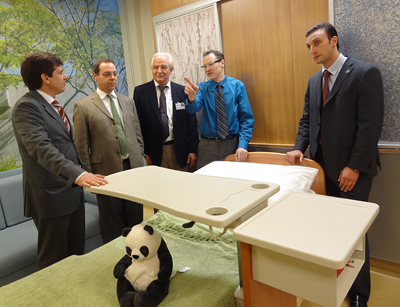Mission Bay Medical Center Stands as a Model of Innovation Across the Globe

Richard Hamilton and David Meates, hospital executives from Christchurch, New Zealand, tour the UCSF Mission Bay Hospital Project on Sept. 13.
UCSF Medical Center at Mission Bay won't be complete for another two years, but the project already has firmly established itself as a model for innovation throughout the world.
Since 2011, groups from 12 different countries have visited the project site to learn more about UCSF’s approach to hospital design, green building practices and state-of -the-art healing environments. The international delegations have included hospital executives, health care providers, engineers, architects and even high school students.

Cindy Lima, executive director of the Mission Bay Hospitals Project at UCSF, speaks with executives from Christchurch, New Zealand, about the project.
“The common factor that has attracted so much global attention is our commitment to innovation,” said Stuart Eckblad, director of UCSF Design and Construction for the project. “From our focus on sustainability to the use of mock-up patient rooms, virtual design technologies and integrated project delivery methods, we have raised the bar, and we are delighted our colleagues from near and far are taking notice.”
So far, visitors from the following countries have toured the 289-bed hospital complex that will serve children, women and cancer patients: Brazil, China, Denmark, Finland, Germany, Japan, the Netherlands, New Zealand, Singapore, South Korea, Sweden and Switzerland.
Some of the groups have expressed a general interest in many aspects of the project, while others have come with a more specific purpose. A group from Christchurch, New Zealand, for example, made two separate visits to Mission Bay in order to learn more about UCSF’s seismic safety practices, as Christchurch continues to rebuild after a devastating earthquake in February 2011.
“Collaboration has been at the heart of UCSF Medical Center at Mission Bay from the very beginning, and we welcome the opportunity to share any knowledge that may help others,” Eckblad said.

Mission Bay Hospitals Project leaders show a group from Brazil a patient room as part of a site tour in November to learn more about the project’s sustainability strategy. From left: Brazil Green Building Council President Manoel Gamiero, US/Brazil Consulate Representative Patrick Levy, UCSF Project Director of Design and Construction Stuart Eckblad, Stantec Architect Tyler Krehlik and Brazil Green Building Council CEO Felipe Faria.
Most recently, a group from Brazil toured the Mission Bay site to learn more about the project’s sustainability strategy while in San Francisco for the 2012 Greenbuild Conference. The new hospital complex, designed by Stantec Architecture, is on track to be certified LEED Gold by the U.S. Green Building Council’s Leadership in Energy and Environmental Design, with energy and water conservation measures, green spaces and use of non-toxic materials among the most extensive of any urban U.S. hospital.
Felipe Faria, CEO of Brazil’s Green Building Council, answered some questions about the group’s interest in the UCSF project and what he believes they gained from their visit.
Q: How did you become aware of UCSF Medical Center at Mission Bay, and what attracted you to learn more about it?
A: While attending the Greenbuild conference, we wanted to take specially guided tours of successful examples of sustainable construction in San Francisco. UCSF Medical Center at Mission Bay was always listed in the suggestions we received from our colleagues at the U.S. Green Building Council. We also received recommendations from the American Consulate in Brazil regarding the excellent work at UCSF Medical Center at Mission Bay. Our group was particularly attracted to the Mission Bay project, since a growing number of health care projects in Brazil have been constructed or retrofitted with higher goals set for energy and water efficiency, as well as indoor air quality. Like the UCSF facility, some of these projects are also aiming for LEED certification.
Q: How do green building practices play into your interest in the UCSF project?
A: I observed that the UCSF project has been developed to view the treatment of individuals and families as its main asset. The design that provides natural ventilation and natural lighting — as well as the use of energy and water efficient technologies — impressed us greatly, but these advances are also used to guarantee a healthier and more comfortable place for the people that will work and be treated there. That was also incredibly impressive.
Q: What were you hoping to gain from your visit to UCSF Medical Center at Mission Bay and, in retrospect, what was most valuable about your visit?
A: I think the most significant highlight noticed by our delegation was the skill set of the project team leaders and their ability to integrate professionals from various disciplines to collaborate on achieving energy efficiency, indoor air quality, water efficiency and the use of environmentally friendly materials. With this approach, you can better understand the cost cycle assessment of the building and all the benefits that you can have when investing in efficiency and air quality.
Q: How do you think UCSF Medical Center at Mission Bay serves as an example for a “hospital of the future?”
A: The hospital of the future is a hospital that minimizes building operation costs through the use of environmentally conscious practices. The hospital of the future also offers comfortable spaces for patients and visitors that encourage speedy recuperation, and the well-planned hospital assists clinicians to make their jobs easier. All of these elements are features that we observed being implemented in the UCSF Medical Center at Mission Bay. Our expectation is that these practices will motivate others in health care to follow the same example.